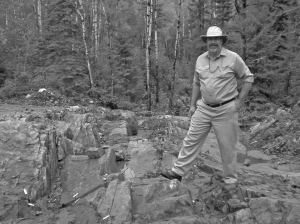Seventy-six per cent of the holes Houston Lake Mining (HLM-V, HLKMF-o) has drilled on its Dogpaw Lake property, near Kenora, Ont., have intersected values of 3 grams gold per tonne or higher.
Assay results from its 3,209-metre drill program include one hole that intersected 1.5 metres grading 15.98 grams gold per tonne.
Dogpaw is one of eight contiguous properties that make up Houston Lake’s West Cedartree gold project, about 40 km southeast of Kenora.
One of those properties, Angel Hill, a couple of kilometres away, has a National Instrument (NI) 43- 101 inferred resource of 106,400 tonnes grading 2.97 grams gold per tonne for 10,160 oz. and is open in all directions.
Brian Mox, an analyst at Max Capital in Toronto who covers Houston Lake, says the results at West Cedartree and Dogpaw look promising.
“It’s still early days but what I like about (the mineralization at) Dogpaw and the rest of the project is just its proximity to surface,” Mox told The Northern Miner.
“They’re finding small pods of mineralization throughout the property so you don’t have a massive deposit in one location but you’re getting nice, shallow, decent pods of good grades.”
Dogpaw has an exploration history dating to the 1940s. Houston Lake’s delineation drill program is intended to upgrade a portion of the historic resource at Dogpaw’s No. 1 vein (53,741 tonnes grading 15.43 grams gold per tonne) to modern standards.
A total of 5,270 metres of diamond drilling was completed in 47 holes. Samples assayed from trace mineralization to 435.6 grams gold per tonne. The best result came from hole DP-2007-042, which yielded 7.5 metres grading 29.9 grams gold.
Continuity of the No. 1 vein system has been established to a depth of 210 metres and traced along strike for 310 metres to include veins No. 2 and No. 4. The No. 2 vein has been defined to a depth of more than 140 metres and for a distance of at least 100 metres along strike.
“We started out with the premise that it was a small resource and what we’ve been able to do is expand the gold mineralization laterally from about 100 metres to 310 metres along strike; we’ve detected two extensions of that veining system and we’ve proved the gold extends for that 310 metres,” says Grayme Anthony, Houston Lake’s president and chief executive. “We think we’ve impacted the original historic resource at Dogpaw significantly.”
Houston Lake plans to release an NI 43-101 resource calculation on Dogpaw by the spring. If the resources are solid at Dogpaw and another property, Dubinsky, the company envisions a central grinding mill onsite that would treat ore from an open pit at Angel Hill and a second pit at Dogpaw.
The company raised $1 million in working capital in September and with drilling and exploration costs down by one-third since the summer, Anthony says he is confident Houston Lake can move ahead with its plans.
“Our financial situation as of September 30 was actually better than it was in March,” Anthony says, adding that the company’s share price, while being affected by the downturn, has not been impacted as severely as some other companies.
Houston Lake explores for gold, platinum group metal and rare earth deposits in northwestern Ontario with a focus on West Cedartree.
The geology of West Cedartree consists of basaltic lavas and pyroclastics intruded by gabbro and quartz feldspar porphyry sills. Gold mineralization is associated with north-south-trending shear zones at the contact of or internal to the gabbro sills.
At presstime, Houston Lake was trading at 30¢ per share. Over the last year, the stock has traded in a range of 21-74¢ per share. The company has 31.2 million shares outstanding.


Be the first to comment on "Dogpaw Fetches Good Grades For Houston Lake"